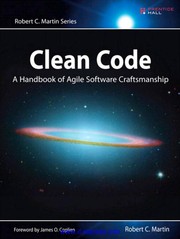You are reading this book for two reasons. First, you are a programmer. Second, you want to be a better programmer. Good. We need better programmers.
Check nearby libraries
Buy this book

This edition doesn't have a description yet. Can you add one?
Check nearby libraries
Buy this book

Previews available in: English
Showing 1 featured edition. View all 13 editions?
| Edition | Availability |
|---|---|
|
1
Clean Code: A Handbook of Agile Software Craftsmanship
July 2008, Prentice Hall
Taschenbuch
in English
0132350882 9780132350884
|
aaaa
Libraries near you:
WorldCat
|
Book Details
Table of Contents
Foreword
Introduction
On the Cover
Classifications
The Physical Object
ID Numbers
Source records
Internet Archive item recordBetter World Books record
Library of Congress MARC record
Internet Archive item record
ISBNdb
Excerpts
added anonymously.
Community Reviews (1)
Feedback?
Pace 1
Medium paced
100%
Clarity 1
Incomprehensible
50%
Succinct
50%
Difficulty 1
Intermediate
50%
Advanced
50%
Breadth 1
Not comprehensive
50%
Focused
50%
Genres 1
Paranormal
100%
Mood 1
Fearful
50%
Scientific
50%
Impressions 1
Recommend
100%
Length 1
Medium
50%
Long
50%
Credibility 1
Outdated
100%
Features 1
Proofs
100%
Content Warnings 1
Trigger warnings
33%
Adult themes
33%
Insensitivity
33%
Style 1
Jargony
100%
Purpose 1
Broaden perspective
50%
Problem solving
50%
| September 1, 2024 | Edited by Drini | Edited without comment. |
| December 17, 2023 | Edited by Tom Morris | Merge works |
| December 17, 2023 | Edited by Tom Morris | Remove bad author |
| December 17, 2023 | Edited by Tom Morris | Merge works |
| February 9, 2017 | Created by Mek | Added new book. |











